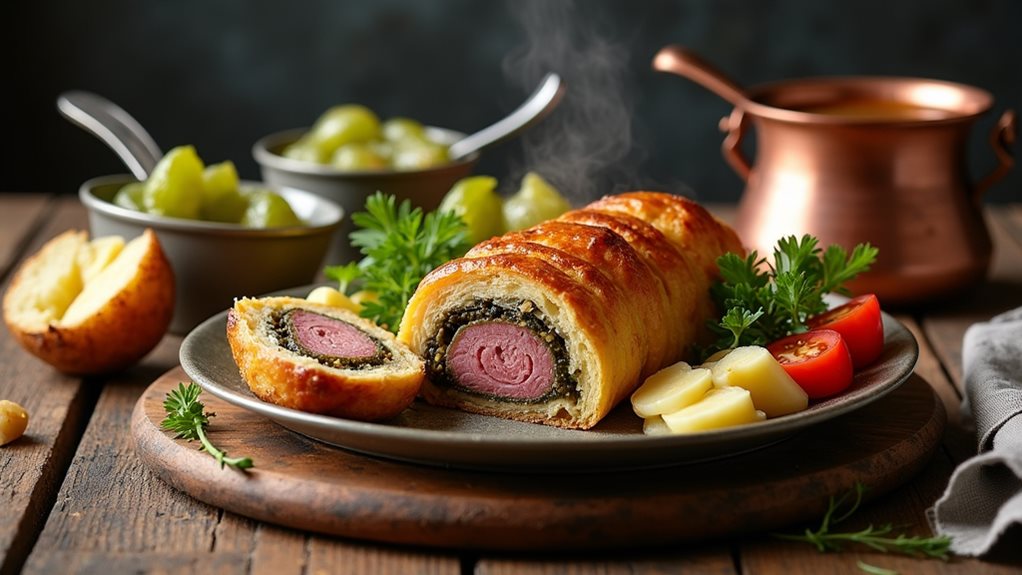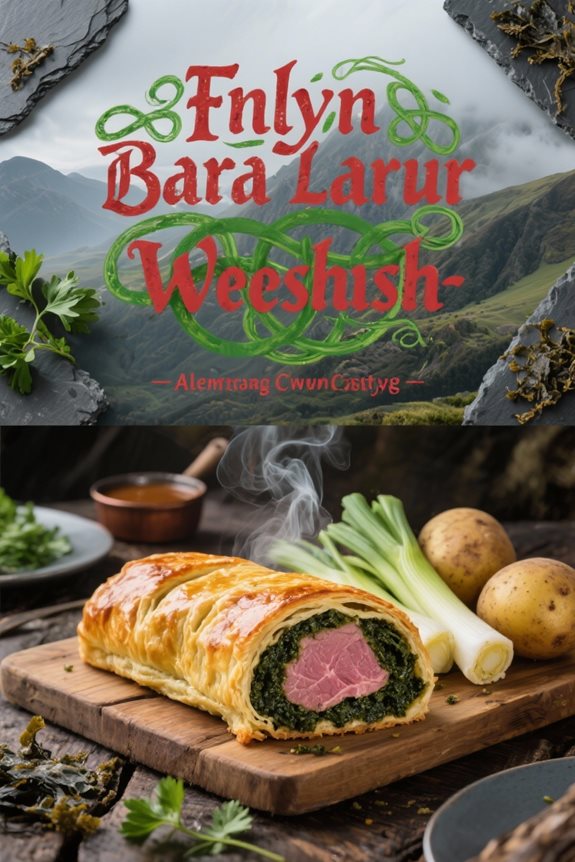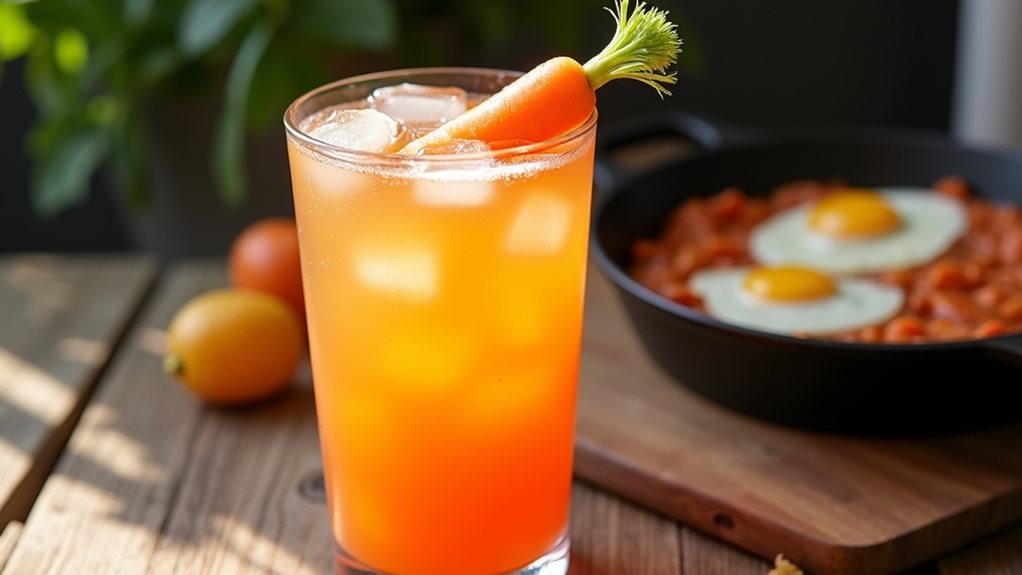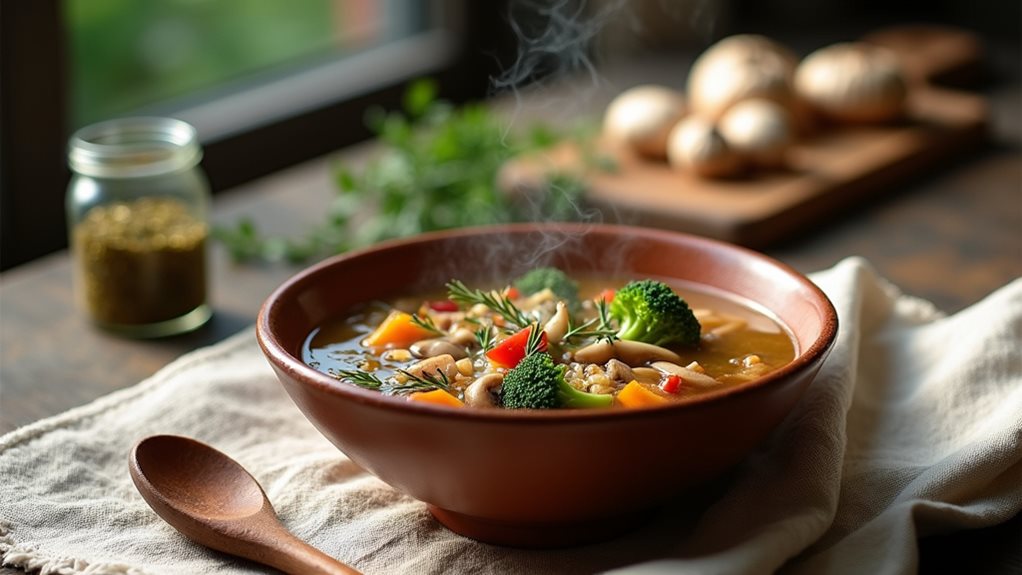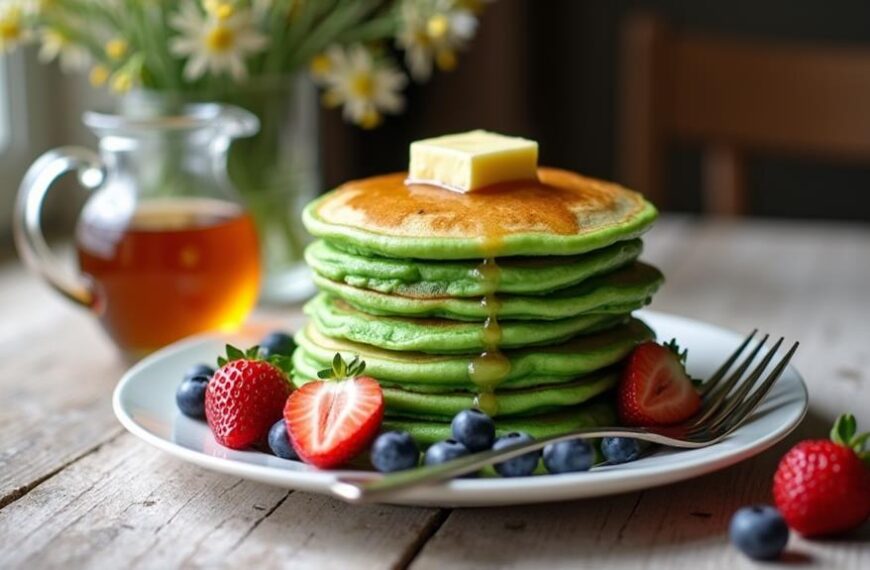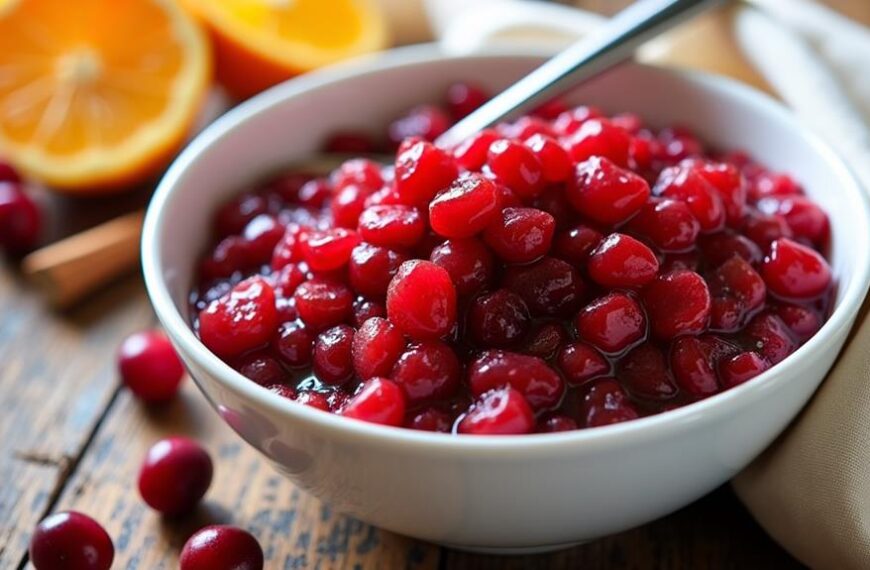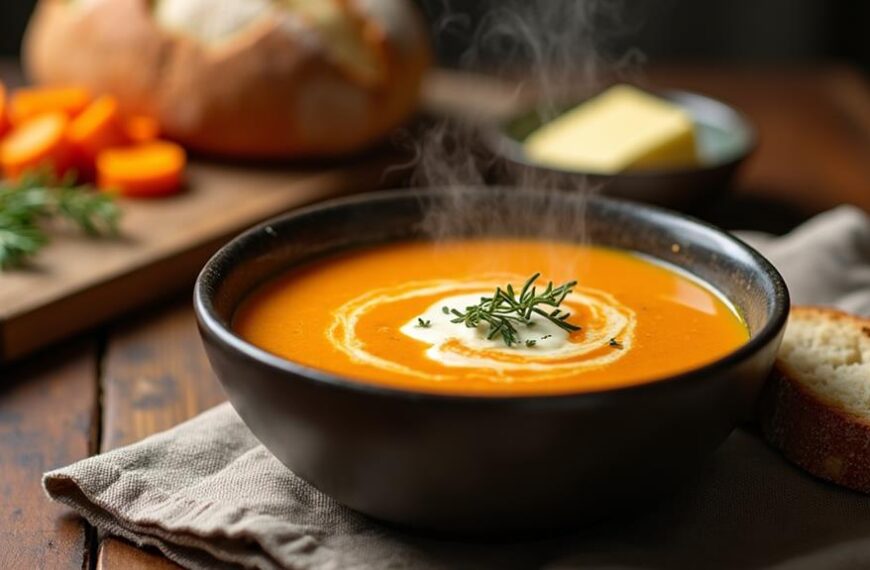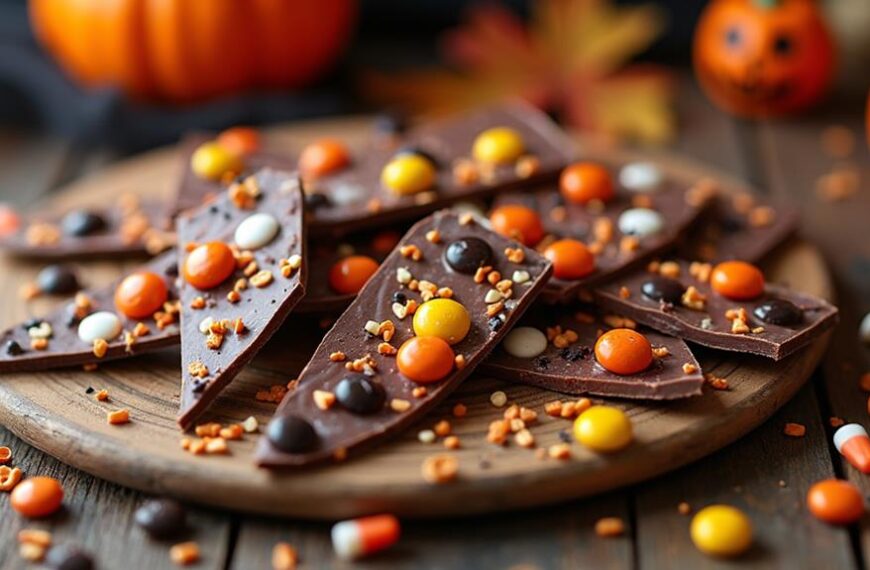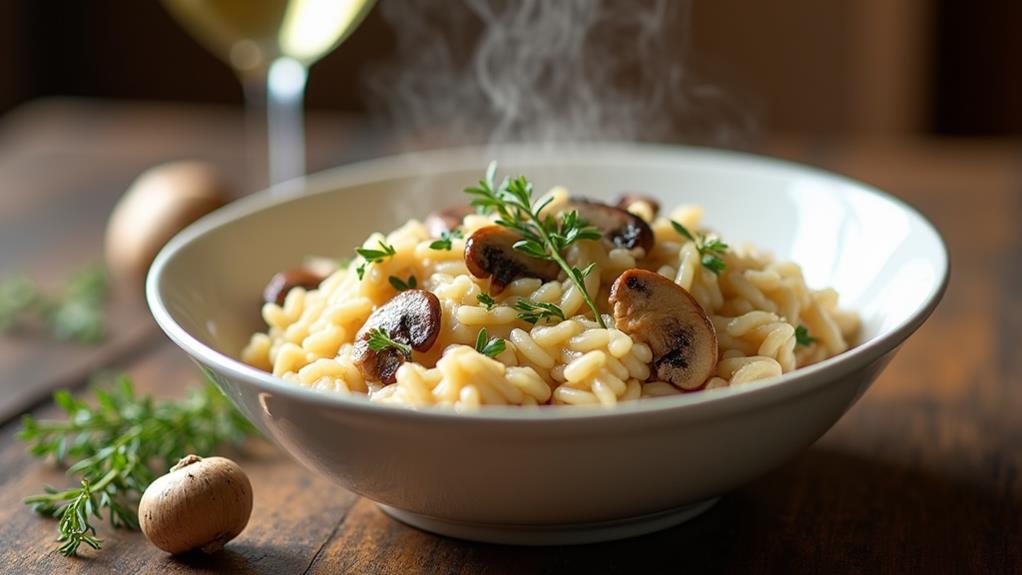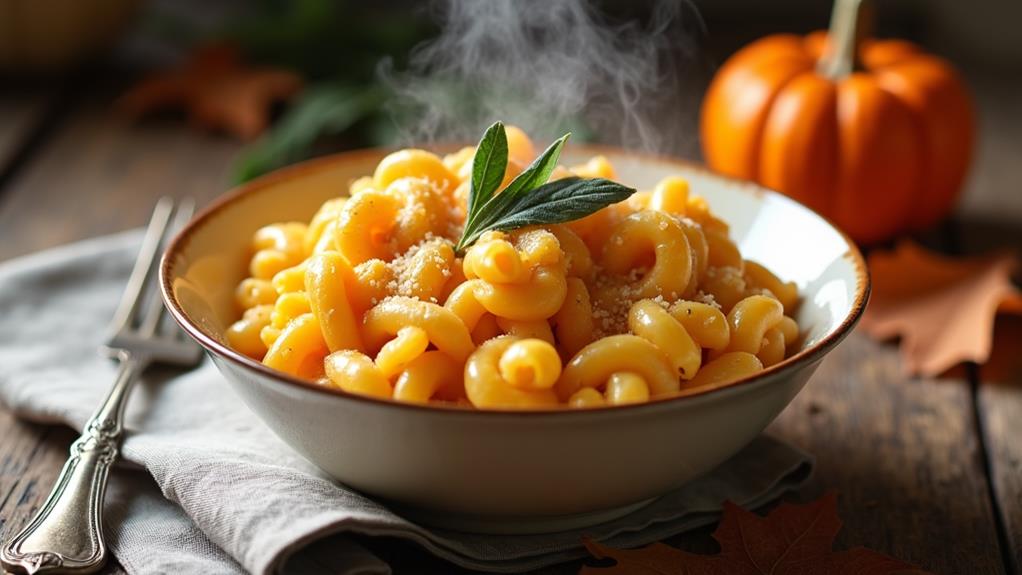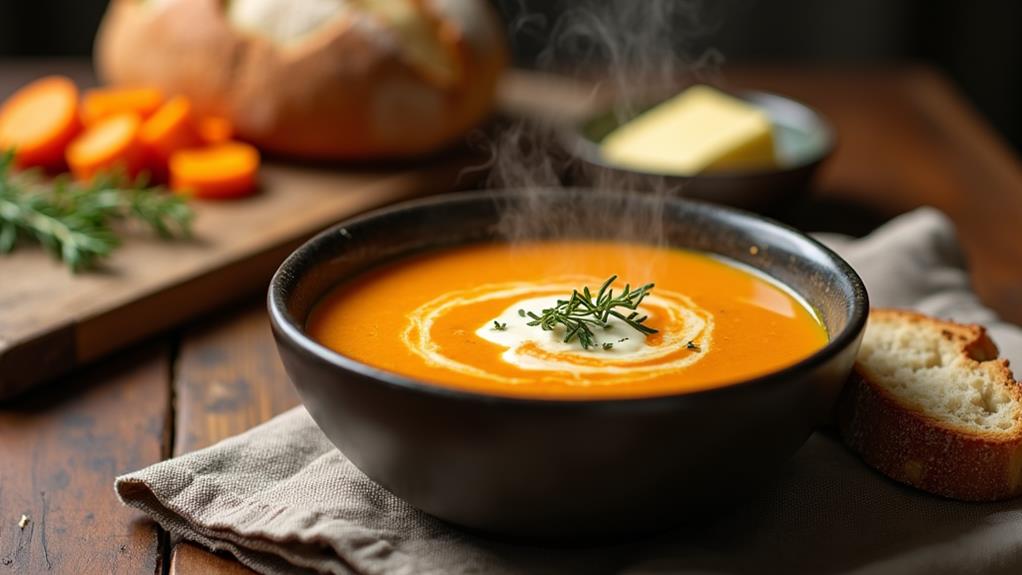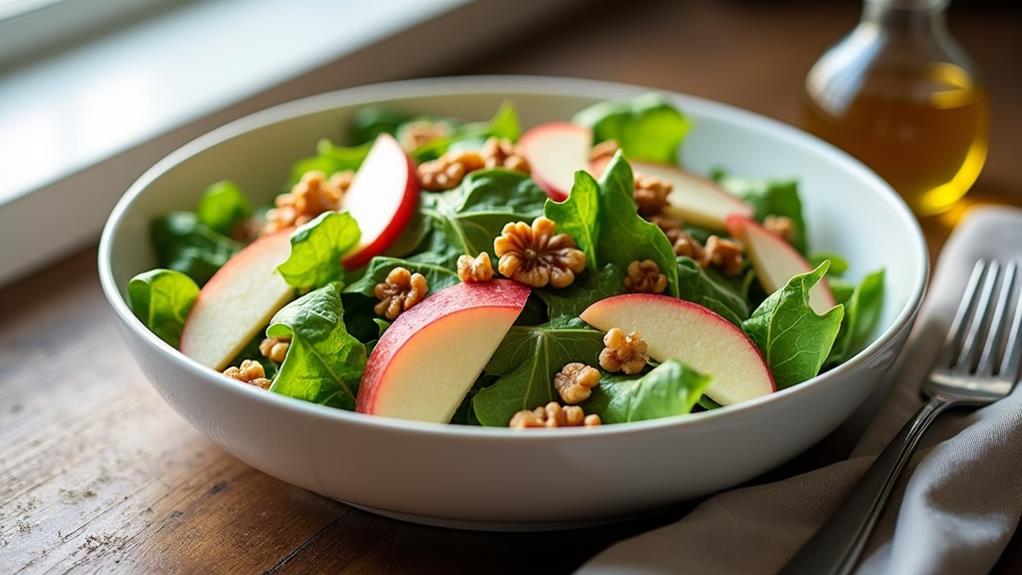I’m excited to share one of Wales’ most treasured culinary combinations – lamb and laverbread wrapped in golden pastry. This traditional dish, “Fnllyn Bara Lawr a Oen Cymraig Alewn Crwstyn,” might look intimidating with its Welsh name, but I’ll guide you through creating this savory treat step by step. The marriage of succulent lamb with mineral-rich seaweed creates a flavor profile you won’t find anywhere else in British cuisine. Let’s discover how these humble ingredients transform into something truly spectacular.
Key Takeaways
- “Fnllyn Bara Lawr a Oen Cymraig Alewn Crwstyn” translates to Welsh Lamb and Laverbread Rolls in a Pastry Crust.
- This traditional Welsh dish combines lamb loin with laverbread (seaweed) in a shortcrust pastry wrapper.
- The stuffing features a mixture of laverbread, breadcrumbs, onions, mushrooms, and parsley.
- The dish is prepared by stuffing lamb loin, roasting it, then wrapping in pastry for a second bake.
- Traditional accompaniments include braised leeks, jacket potatoes, and pairs well with Welsh ale.
Why You’ll Love these Welsh Lamb & Laverbread Rolls
Tradition and innovation combine beautifully in these Welsh Lamb & Laverbread Rolls, creating a dish that’s both deeply rooted in Welsh culinary heritage and perfectly suited for modern entertaining.
I’ve found that the rich flavor of lamb pairs extraordinarily well with the distinctive taste of laverbread, a traditional Welsh seaweed delicacy that adds depth and umami.
What makes this recipe special is its impressive presentation—the golden pastry crust conceals tender lamb and a savory stuffing that will delight your guests.
The combination of breadcrumbs, mushrooms, and onions creates a perfect texture contrast with the meat. Plus, it’s versatile enough for special occasions yet manageable for weekend family dinners when you want something beyond the ordinary.
What Ingredients are in Welsh Lamb & Laverbread Rolls?
Welsh Lamb and Laverbread Rolls are a traditional Welsh dish that combines the rich flavors of lamb with laverbread, a Welsh delicacy made from seaweed. This recipe creates an impressive main course that showcases classic Welsh ingredients. The combination might sound unusual if you’re not familiar with Welsh cuisine, but the savory lamb pairs wonderfully with the unique umami flavor of laverbread in the stuffing.
- 1½ pounds loin of lamb
- 12 ounces shortcrust pastry
- 3 ounces onions
- 4 ounces drippings (fat)
- 1 ounce mushroom pieces
- 4 ounces breadcrumbs
- 2 ounces laverbread
- Fresh parsley, chopped
- Milk (approximately ½ cup)
- Salt and pepper for seasoning
- Eggs (for egg wash)
- Tomatoes, sliced (for garnish)
When shopping for these ingredients, the laverbread might be the trickiest to find if you’re not in Wales. It’s a purée made from cooked seaweed (specifically laver, or Porphyra) and is available in specialty stores or online. The quality of your lamb is important too—try to find Welsh lamb if possible for authenticity, though any good quality loin will work. The drippings can be substituted with butter or oil if needed, but the traditional flavor comes from using animal fat. And don’t skimp on the pastry—a good shortcrust makes all the difference in this showstopping dish.
How to Make these Welsh Lamb & Laverbread Rolls
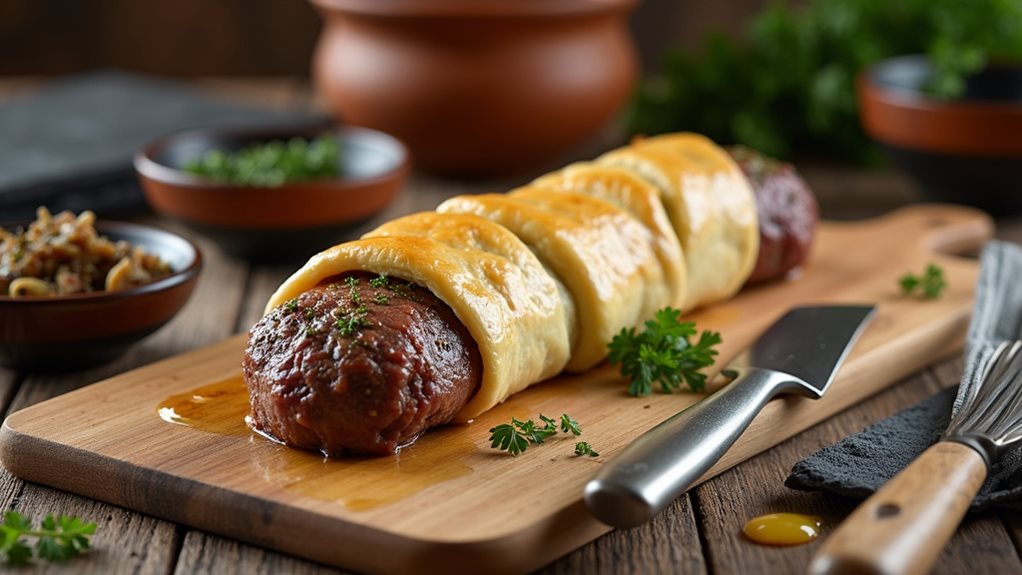
To prepare this traditional Welsh delicacy, you’ll begin with a 1½ lb loin of lamb that needs to be carefully skinned and boned.
Once prepared, finely chop about 3 ounces of onions and sweat them in 2 ounces of dripping until they’re soft and translucent. Then add 1 ounce of finely chopped mushroom pieces and cook for another 2 minutes until they release their earthy aroma. This aromatic mixture forms the base of your stuffing, to which you’ll add 4 ounces of breadcrumbs, 2 ounces of laverbread (that distinctive Welsh seaweed delicacy), and some freshly chopped parsley. Mix everything to a creamy consistency with a little milk—just enough to bind it all together—and season to taste.
Now comes the fun part—stuffing and wrapping the lamb. Take your prepared loin, stuff it with your laverbread mixture, and tie it securely. Season the outside, then seal it by brushing with melted dripping before roasting in a hot oven at 430°F for about 30 minutes.
After roasting, let the lamb cool completely and drain any excess fat. While it’s cooling, roll out 12 ounces of shortcrust pastry into a rectangle about 5/16 inch thick. Spread the remaining stuffing over the pastry, leaving a 2-inch margin all around. Place your cooled lamb loin on top, brush the pastry margins with beaten egg, then carefully wrap the pastry around the meat, sealing it completely.
Turn the wrapped loin over so the seams are underneath, place it on a greased baking sheet, brush the top with more beaten egg, and decorate as desired. The final bake needs about 30 minutes in a 425°F oven.
When done, garnish with fresh parsley and sliced tomatoes for a colorful finish. The traditional accompaniments are braised leeks, jacket potatoes, and a rich brown sauce—proper Welsh comfort food that’s worth every minute of preparation. For an easier preparation method, consider using a professional slow cooker to tenderize the lamb before wrapping it in pastry.
Welsh Lamb & Laverbread Rolls Substitutions and Variations
While laverbread and Welsh lamb create an authentic version of this traditional dish, you’ll be pleased to know that several substitutions can make this recipe accessible regardless of your location or dietary preferences.
If you can’t find laverbread, spinach mixed with a small amount of minced nori provides a similar earthy, briny flavor profile. For those avoiding lamb, beef tenderloin works beautifully, though you’ll want to adjust cooking times accordingly.
The shortcrust pastry can be replaced with puff pastry for a lighter texture, or for gluten-free diets, try commercially available gluten-free pastry mixes.
I’ve found that adding herbs like rosemary or thyme to the stuffing creates delightful variations, while incorporating Welsh cheese like Caerphilly into the breadcrumb mixture adds a distinctive regional touch.
What to Serve with Welsh Lamb & Laverbread Rolls
Traditional accompaniments elevate Welsh Lamb & Laverbread Rolls from a standalone dish to a complete dining experience, with several regional favorites that highlight the pastoral heritage of Welsh cuisine.
The original recipe specifically recommends serving the rolls with braised leeks, jacket potatoes, and brown sauce—a trio that perfectly balances the rich flavors of the lamb and laverbread.
I’ve found that adding a bright side salad with a light vinaigrette cuts through the heartiness of the dish.
For a truly authentic Welsh meal, consider including cawl (Welsh soup) as a starter or serving bara brith (speckled bread) for dessert.
If you’re hosting a dinner party, a Welsh ale or medium-bodied red wine complements the earthy flavors of this traditional dish wonderfully.
Final Thoughts
Looking back at this classic Welsh recipe, I’m struck by how Fnllyn Bara Lawr a Oen Cymraig Alewn Crwstyn represents both culinary heritage and resourcefulness.
The combination of tender lamb with laverbread—a traditional Welsh seaweed delicacy—wrapped in flaky shortcrust pastry creates a dish that’s both elegant and rustic.
What makes this recipe special is how it transforms simple ingredients into something magnificent.
The careful layering of flavors—from sweated onions to earthy mushrooms and the distinctive taste of laverbread—shows the sophistication of Welsh cooking that’s often overlooked in discussions of British cuisine.
Much like watercress soup’s evolution through various regional adaptations, this Welsh dish showcases how local ingredients can be elevated through thoughtful preparation.
I hope you’ll try this recipe and experience this delicious part of Welsh culinary tradition.
It’s a wonderful way to connect with Wales’s rich food heritage and impressive technique.

